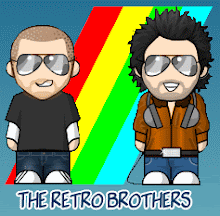
Acorn Atom
The mighty Atom.
The Acorn Atom was the ancestor to the BBC series of computers manufactured by, you guessed it, Acorn.They seemed to like to name their machines with scientific names (Atom, Electron) - if they were still going today would be have the Acorn Proton? Or Nucleus? Anyway, like the ZX80 and ZX81 (which were both soon to follow) it was sold in kit form or ready-assembled versions (at an extra cost).
The great advantage of the Atom compared to its competitors (The TRS-80 & Commodore PET), was its high resolution display capabilities (256 x 192 was achievable) which was quite unusual way back in the bell-bottomed and hanglider collar ridden era of 1979. Especially for the price (Kit form: £120 ready assembled: £170).
The built in BASIC did have some limitations, such as only being able to use integer variables. An optional 4K ROM could be added to the machine and gave the programmer the ability to use floating point numbers, trigonometric functions to convert degrees/radians and also to draw graphics in color.
Being able to see graphics in colour during the era of disco was truly a sight to behold. More add-ons were also available to enable autonumbering, a faster cassette interface (running at an incredible 1200 bauds), and functions such as INKEY$, MID$, READ, DATA, FILL and so on. There was even a BBC BASIC board available.
Speed, as of other machines during the era was pretty standard at 1Mhz, courtesy of a 6502 processing unit.
A lot of applications were available on sideways ROMs that plugged into the spiffily named "utility ROM socket", such as the "Atom Word Pack ROM" which could be used for word processing or Atom-Calc, which was a 4K ROM spreadsheet. It doesn't sound quite as cool as Excel does it?
A colour card could be connected to the BUS connector, to give the system eight colors, 4 simultaneously at the 64 x 192 resolution or 2 at 128 x 192 for example. Mind you, you needed asbestos gloves if you went anywhere near one of these baby's as they tended to overheat dramatically.
The sound generator was a simple beeper, similar to the beeper that would be installed inside the ZX Spectrum a couple of years down the line. Still, any sound on a home micro at this point in time was a Brucey bonus! It was possible to expand the sound generated by directly accessing the sound I/O port and manipulating it at a certain frequency - the first ever home computer fart was generated this way.
The machine itself does resemble it's later offerings (such as the BBC Micro) in appearance, using a similar colour scheme and style. None of them ever stood out to the eye when sitting on the shelf. What was packed away inside really counted.
A lot of other peripherals were developed for the machine including:
- A 5.25 inch floppy disk drive which was capable of storing 100K of data. This held the DOS in a 3K ROM but actually cost about twice as much as a new Atom. Did they use an integer based program to work out the price?
- A digital-tape recorder, yes that is correct, a DIGITAL TAPE RECORDER!
- A printer interface.
- A network card known as 'EcoNet' which could enable the linking of up to 250 Atoms running at 210 K/Bauds transfer rate. A network without windows! RAM expansions were also available.
Whilst it was never a classic games machine, this machine really got the company moving.
Those guys at Acorn were really ahead of their time in many ways eh?
We recommend trying to pick up one of these machines.
Look at computers for sale online or even locally.
If you don't want to get hold of the real hardware then try and download an emulator and download those classic games. Alternatively you could try and play them online.
NAME: ATOM
MANUFACTURER: Acorn Computers
MACHINE TYPE: Home Computer
COUNTRY OF ORIGIN: United Kingdom
RELEASE YEAR: (1979 production) 1980
END OF PRODUCTION: 1983
BUILT IN LANGUAGE(S): Basic and machine code
KEYBOARD: QWERTY full-stroke keyboard containing 60 keys
CPU: 6502
SPEED: 1 mHz
CO-PROCESSOR: 6847 Video Display Generator, PIA 8255 (keyboard and tape)
RAM: 2 KB (but up to 12 KB was availbale, or 32 KB using an external RAM expansion kit) VRAM 6 KB
ROM: 8 KB (Atom BASIC and COS), up to 16 KB
TEXT MODES: 32 x 24 / 16 x 12
GRAPHICS MODES: 64x64 (4 cols), 64x96 (4 cols), 128x96 (monochrome), 64x192 (4 cols), 128x92
COLORS: 8
SOUND: Built-in beeper
SIZE / WEIGHT: 15'' long x 9.5'' deep x 2.5'' high
I/O PORTS: Tape interface, UHF Modulated TV output, Acorn Bus Extension
POWER SUPPLY: External PSU - 8v 2A
PRICE: Kit form retailed at £120 Ready made retailed at £170 (UK, 1983)
Retro Computers and classic games




3 comments:
My Mum bought me one of these, which I still have and is still going strong, with the 12K RAM pack too!
Spent most of my time writing assembler to make weird noises though I did have a chess cassette for it too (even the Atom could usually beat me at that). The cassette never worked well so the days work was lost when I switched it off. Put me in good stead though, I'm now a software architect at a multi-national aerospace company. Well done Mum :)
www.spottelefon.org
replika telefonlar
Post a Comment